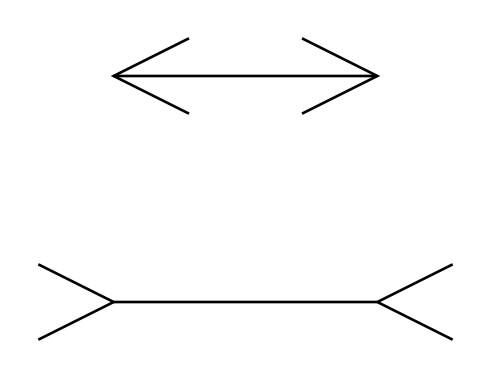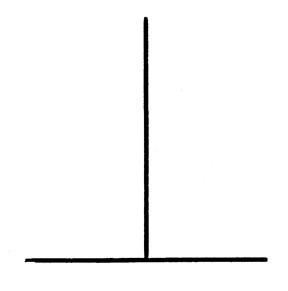November 15, 2016
Don’t Think Too Fast: How to improve your everyday decision-making process?

Understand and learn to avoid mistakes that everyone makes every day. Knowing your biases is a way to improve the decisions you take, for yourself and your company.
Intuitive Fast Thinking
Look at the picture below:

The second horizontal line is longer, right? Wrong. The two lines actually share the same length.** And even if you already knew about this popular “two lines illusion” before, you can not avoid falling into the trap. **The second line definitely* appears to be* longer for us human beings.
Your brain (now) knows the fact that the two lines have the same length, but you still have this slightly different perception of reality. Let’s do it one more time. But this time I tell you beforehand that the horizontal and the vertical lines are similar. Now look at the picture:

The vertical line still looks longer! o.o
Basically, your perception is intuitive, immediate, and fast, but — sadly — can be wrong.
It is precisely the same intuitive thinking that allows you to instantly know the result of “1+1”. Even if you did not want to compute it just now, the result probably popped up in the back of your mind. It is also your intuition that operates every time you cross the road. By taking into account the estimated speed of the incoming cars, the estimated distance from the cars and from the other side of the street. Your intuition takes a decision in a few milliseconds. How cool and powerful is that!
So why our brain is able to solve the “should I cross the road now” problem in milliseconds and is failing at measuring lines? You can see your first intuition as a fast but biased thinking tool.
“Rational” Slower Thinking
Wait for a second, isn’t that supposed to be the other way around? One should rather fail at modeling a car’s behavior instead of getting the length of two lines.
In his prodigious book Thinking, Fast and Slow, Daniel Kahneman emphasizes the two different “thinking systems” each individual can use. What you experienced with visual illusions is the result of your brain operating automatically and quickly.
But it is different if you want to allocate attention to more effortful mental activities like complex computing: what is the result of “17*8”?
If you tried to compute it, then you experienced your second thinking system. This is the one you maybe thought was the only one. The more rational one.
How does that affect our everyday decisions?
Your daily life is full of decisions. If you are a startup executive, your job is only about taking the right decisions. And you have to take them quickly.
But fast decision-making should not be relying only on your intuition. Because otherwise, that is how you take bad decisions.
Just as how “1+1” is much easier than “17*8”. People tend to prefer using their intuition to take fast decisions. But like in the two lines illusion, it is more frequently subject to errors that way. If you have to measure the two lines, what you should do is take a ruler, not rely on the first answer that seems obvious to you.
To reduce your bias and take good decisions, use your slow thinking skills.
3 Steps to improve your decision-making
1. Think twice
If it takes 5 machines 5 minutes to make 5 widgets, how long would it take 100 machines to make 100 widgets?
If you read everything until this point, you probably understand that the really tempting answer that comes to your mind (i.e. “100”) is not correct. With a little effort, you guess that the correct answer is 5 minutes (with 20x more machines, you make 20x more widgets during the same period of time).
When Princeton students took this test, 90% failed. But the interesting part is when other students were asked to solve the same question written in a barely legible washed-out gray print: only 35% failed instead of 90%. Why? Because when the text is difficult to read, people pay attention and then avoid mistakes caused by intuition.
Some studies show that using a foreign language also makes you think twice.
2. Stop avoiding “slow” thinking!
Thinking “slow” is not hard, everyone can do it. But it’s painful. Would you want to compute “47*15” right now for fun? Probably not.
However, taking the right decisions requires slow and rational thinking. Therefore it should painful.
You might absolutely NOT make yourself comfortable by avoiding these painful decisions. As an individual or as an executive, one pitfall is to only rely on your intuition. A good CEO does not take fast decisions by solving as many “one-digit additions” problems as possible in a day. A good CEO solves as many painful “two-digits multiplications” instead.
Mark Zuckerberg (and also Barack Obama) wears the same outfit every day. Since each decision is precious, that allows him to save one more decision for their his responsibilities as a CEO.
So stop being lazy and make a little mental when taking decisions.
3. Beware of your biases
Do you think there are more Playstation or Xbox players in your country?
To answer this question, you probably thought of all your friends and console players you know, and then came to a conclusion. And people do that most of the time, even if it obviously biased. But your friends can not possibly be representative of the market situation of a whole country.
Your judgment is often affected by yourself, your assumptions, and your stereotypes. Here is a basic and simple case in point:
It’s not because the font is bold that a sentence is more likely to be true!!
So don’t think too fast every time you take a decision! Even if our intuition is really powerful, there are so many biases that prevent it from being rational.
Thanks for reading!
If you enjoyed this article you will love this book! For more explanations about how illusions can trick our brains, check for Ponzo Illusions.